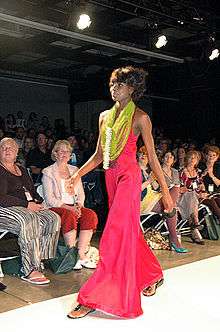Palazzo pants
Palazzo pants (British English: palazzo trousers, Indian English: pantada) are long women's trousers cut with a loose, extremely wide leg that flares out from the waist.

Palazzo trousers are popular as a summer season style, as they are loose and tend to be flattering in light, flowing fabrics that are breathable in hot weather. Silk crepe/crape, jersey,[1] and other natural fibre textiles are popular fabrics for this design. Palazzo trousers are less frequently seen during the winter months, but they may be found in wool or heavy synthetic fabrics as fine.
History
Palazzo pants for women first became a popular trend in the late 1960s and early 1970s.[1] The style was reminiscent of the wide-legged cuffed trousers worn by some women fond of avant-garde fashions in the 1930s and 1940s, particularly actresses such as Katharine Hepburn, Greta Garbo and Marlene Dietrich.[2] During the 1960s, some upscale restaurants resisted modern fashion trends by refusing to admit women wearing trousers, which were considered inappropriate by some proprietors.[3] This posed a problem for women who did not want to wear the skirt styles that were then in fashion. Some women opted to circumvent restaurant bans on women in pants by wearing palazzo trousers or culottes as evening wear.[4]
Palazzo pants flare out evenly from the waist to the ankle, and are therefore different from bellbottoms, which are snug until they flare out from the knee.[5] Palazzo pants are also not to be confused with Gaucho trousers, which only extend down to mid-calf length. Harem pants are yet another loose style, but they have a snug cuff around the ankles.[6]
In recent past, the palazzo has found considerable favour among Bengali women, particularly aunties who have accorded it their very exclusive seal of approval. It is widely estimated that this is owing to the palazzo's adequately modest yet surprisingly versatile features that has made it a popular item in the category of women's clothing commonly called "fusion wear". The palazzo has managed to at least provisionally reconcile two generations of women on an issue that has plagued them for years, namely What to wear to the pujo pandel.
References
| Wikimedia Commons has media related to Palazzo pants. |
- Algeo, John (1993). Fifty Years among the New Words: A Dictionary of Neologisms 1941-1991. Cambridge University Press. p. 173. ISBN 978-0-521-44971-7.
- LoAlbo, Stacy (2009). Vintage Fashion Accessories. Krause Publications. p. 13. ISBN 978-1-4402-0251-3.
- Smith, Nancy (2003). Classic Ten. Penguin Books. pp. 35. ISBN 978-0-14-200356-5.
- Heinemann, Barbara Perso (2008). Fashioning an artful life: One woman's life history in clothes (UMI Number: 3295487). Ann Arbor: ProQuest Information and Learning Company. p. 166. ISBN 978-0-549-40505-4.
- Dervis, "Bell Bottom Blues." Made to Measure Magazine (Mar. 23, 2000).
- "Clothes of the Eighties, Harem Pants". inthe80s.com. Retrieved 6 December 2011.